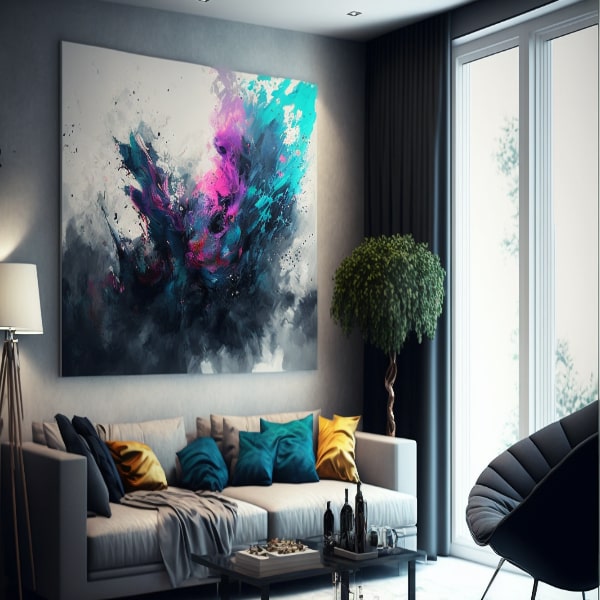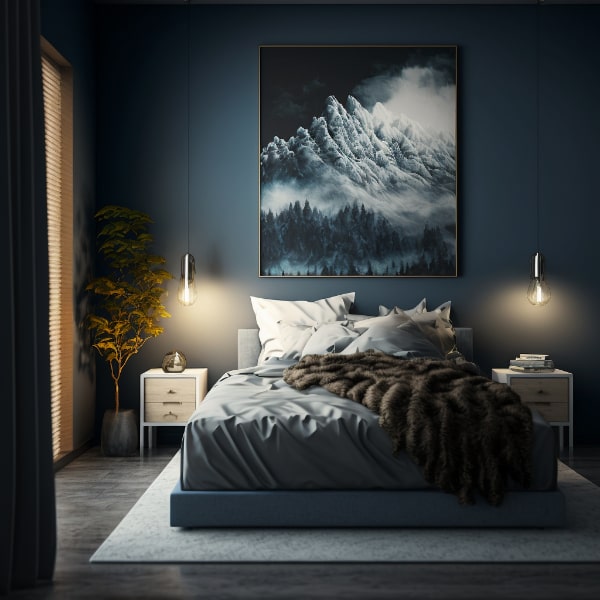A Guide to Finding the Perfect Type of Wall Art Your Home
Adding wall art to your home is an excellent way to express your personality and add a touch of style to your space. But with so many different types of wall art styles available, it can be overwhelming to know where to begin. Not only do you need to choose the type of wall art, canvas, print, metal? you also need to choose the art style. Do you like abstract, or landscapes? vintage or contemporary? There are countless options to choose from, in this post we will explore the different types of wall art as well as the most popular styles, with tips on how to choose the perfect piece for your home. Whether you’re a first-time buyer or renter, this guide will help you make an informed decision about the wall art you choose.
Table of Contents
The Four Most Common Types of Wall Art Styles
When it comes to choosing the style of wall art, there are several options available. The four most common styles of wall art are representational, abstract, contemporary and vintage. Representational art is art that depicts a recognizable subject, such as a landscape or portrait. Abstract art is non-representational art that often uses shapes, colors, and textures to create an overall impression. Contemporary art is art that is created in the present time and often reflects current social and political issues. Vintage art is art that is from the past and can be considered as antique. Each of these types of art styles has its own unique characteristics and can be used to achieve different effects in a room. We will look at all four of these in greater detail below.
What is Abstract Wall Art?
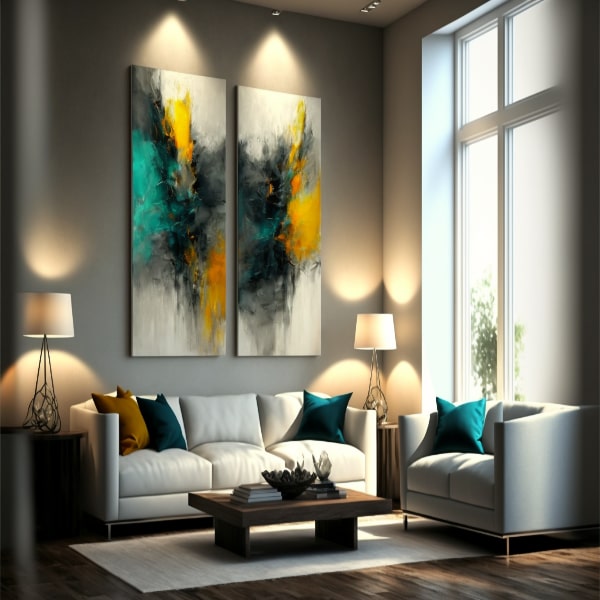
Abstract art is a form of art that does not depict a recognizable subject or object. Instead, it uses shapes, lines, colors and textures to create a composition that is intended to evoke an emotional or intellectual response in the viewer. Abstract art is popular because it allows the artist to express their emotions, ideas and thoughts in a non-representational way. It also allows the viewer to interpret the artwork in their own way, making it a more personal and subjective experience.
Abstract art is particularly popular in modern and contemporary art, It’s well suited for a variety of decor styles and rooms. Its non-representational nature allows it to blend well with other design elements, making it a versatile choice for any room. It’s often used in living rooms, dining rooms, bedrooms and office spaces to add a touch of color and texture to a space. It’s also a great way to add a focal point to a room without being too overpowering.
In terms of decor styles, abstract art can be incorporated into any decorating style, from minimalist to maximalist, as well as any color palette. You can choose abstract art with bold and bright colors to add a pop of color to a neutral room, or opt for more subdued and neutral tones to complement a bold and colorful room.
What is Representational Art?
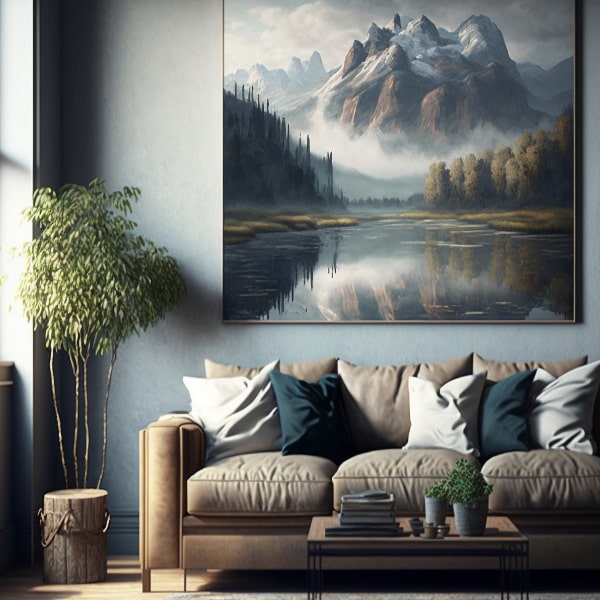
Realistic art, also known as representational art, is a form of art that depicts recognizable subjects or objects in a highly detailed and accurate manner. It is often created to look like a photograph or a mirror image of the subject, and it attempts to capture the reality of the subject as it appears in the world. Realistic art is popular because it allows the artist to create highly detailed and lifelike images that are easy for the viewer to understand and relate to.
Representational art has been popular for centuries, with many famous artists throughout history such as Leonardo da Vinci, Jan van Eyck and Rembrandt working in this style. Even though it’s not as popular as it was in the past, it’s still a classic form of art and has a timeless appeal.
This type of art is well suited to more traditional decor styles, such as classic, romantic, and country. It’s also well suited for more formal spaces, such as dining rooms, living rooms, and hallways.
The type of subject matter that is well suited to realistic art is varied and can include anything from portraits, landscapes, still lifes, and historical scenes. It can be used to depict anything from nature and animals, to people and cityscapes. It can also be used to depict personal memories and experiences, making it a great choice for those looking to personalize their home.
What is Vintage Art?

Artwork from a certain era or style, typically from the past, is referred to as vintage art. The term “vintage” is often used to describe art that is from the 1920s to the 1960s, although it can also refer to older art. It’s popular because it can add a touch of nostalgia and history to a space, and it can also be a great way to incorporate unique and one-of-a-kind pieces into a room.
Recently, vintage art has seen a resurgence in popularity, especially with the rise of vintage and mid-century modern decor styles. It’s well suited to these decor styles and can help to create a retro or vintage vibe in a room. It can also be paired with more contemporary decor styles to add a touch of character and history.
Living rooms, bedrooms, and home offices are great spaces for vintage art, as it can add a touch of personality to a space and can also be used to create a focal point in a room. It’s also well suited to more formal spaces, such as dining rooms, hallways, and entryways.
Vintage art can include a variety of subjects and mediums, such as painting, print, and illustrations. Popular vintage art subjects include landscapes, portraits, still lifes, and historical scenes. In general, it’s best to choose vintage art that complements the color scheme and style of the room it will be placed in.
What is Contemporary Art?
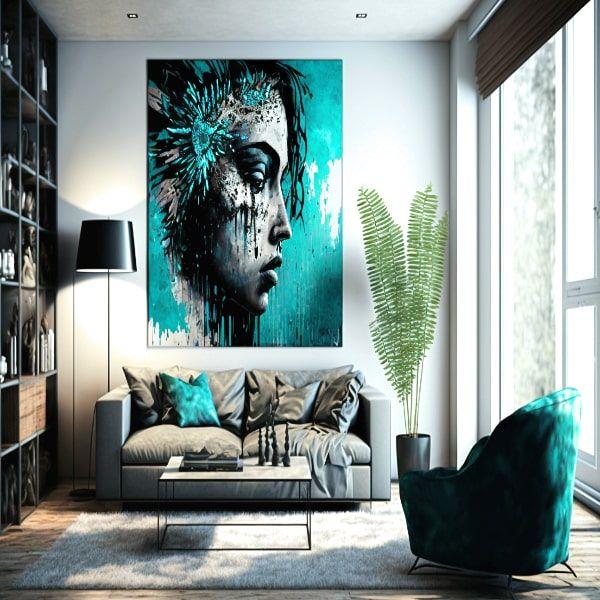
Contemporary art, which is created in the present time, encompasses a wide range of styles, mediums and techniques. It is known for its focus on current social and political issues, as well as new technologies and forms of expression. This type of art is popular as it offers a new way for artists to express themselves and for the viewer to experience it.
Popularity of contemporary art is growing in modern interior design as it adds a sense of freshness and modernity to any room. It complements contemporary decor styles such as modern, minimal, and industrial. Furthermore, it’s a great way to add a focal point to a room, and to break up a monochrome color scheme.
Contemporary art can be used in any room of the home. It’s often used in living rooms, dining rooms, bedrooms, and home offices to add a touch of color and texture to a space. It can also be used in more formal spaces, such as hallways and entryways, to create a sense of modernity and freshness.
Contemporary art can include a variety of mediums such as painting, sculpture, and digital art. Popular contemporary art subjects include abstract and non-representational art, as well as political and social commentary. It’s a great way to add a modern touch to any home and can be used to personalize any space.
Choosing the Right Types of Wall Art Prints
When choosing wall art, it’s important to consider the style of the room where it will be placed. A traditional piece in a modern room or vice versa can clash and disrupt the overall aesthetic. It’s also important to consider the size of the piece in relation to the size of the wall and the room. A small piece may be overwhelmed in a large room, while a large piece may overpower a small room.
One way to decide on the type of wall art that would work best in your space is to start by considering the overall style and mood you want to create. For example, if you want to create a modern, minimalist look, an abstract piece would be a good choice. If you want to create a traditional, classic look, a realistic piece would be a good choice.
Another way to decide on the type of wall art that would work best in your space is to start with a piece you love and build the room’s decor around it. For example, if you find a piece of vintage art that you love, you can decorate the room in a way that complements the vintage style.
Mixing and matching different types of wall art can also be a great way to create a cohesive look. For example, you can mix a contemporary piece with a vintage piece to create a unique and interesting look.
It’s also important to choose a piece that you personally connect with and that fits with the overall aesthetic of your home. While a piece may be considered fashionable, it may not be the right fit for you.
Art Mediums for Wall Art

When it comes to decorating your walls, there are several types of wall decoration materials that are commonly used. The four most common types of wall art are paintings, canvas prints, photographs and tapestries. Original paintings are created by an artist on a canvas, often with acrylics or oils. Prints are reproductions of an original piece of art, such as a painting or photograph, and are usually printed onto a stretched canvas or paper for posters and art prints. Photographs are images captured by a camera which are usually enlarged and framed, while tapestries are large decorative fabrics that are often used as wall hangings. Each of these types of art has its own unique characteristics and can be used to achieve different effects in a room. Here is a general guide to the types of materials art can be displayed on.
- Canvas Mounted Wall Art Prints: This medium involves printing an image onto canvas and then stretching it over a wooden frame. Canvas prints are a popular choice for wall art as they are easy to hang and give the art depth on the wall. Depending on the size and type of canvas you choose, this can be an expensive option.
- Paper Prints: This medium involves printing an image onto paper, such as art prints, posters and giclee print. Paper prints are a great choice for wall art as they are less expensive than canvas, lightweight and easy to frame.
- Photographs: Photography prints are a very popular choice and are a great way to get a one of a kind piece of wall art for your home. They are also very versatile and can be printed on all types of materials.
- Metal Prints: Printing wall art on metal is a relatively new and incredibly popular trend in home decor and is great for creating a modern, contemporary look. They are also durable and easy to clean making them a great choice for any home.
- Wooden Blocks – wood block art is a more recent choice and is also becoming increasingly popular. This is when the art is printed onto a piece of wood, adding texture to the print from the wooden base for a different look. Wood art prints are the perfect choice for a nature or outdoorsy living space.
- Tapestries: These are wall art made from materials and can involve weaving, knitting or printing an image to fabric. Tapestries can be used to create a warm and cozy look in a room and are a good choice for anyone who rents or for student dorms as they are ultimately very portable.
By understanding the different mediums used in wall art, you’ll be able to choose the perfect piece for your home. Each medium has its own unique characteristics and can be used to create different looks and moods.

Mistakes to Avoid When Choosing Wall Art
- Not considering the style and mood of the room: As mentioned earlier, it’s important to consider the style of the room where the wall art will be placed. A traditional piece in a modern room or vice versa can clash and disrupt the overall aesthetic.
- Not considering the size of the piece: It’s also important to consider the size of the piece in relation to the size of the wall and the room. A small piece may be overwhelmed in a large room, while a large piece may overpower a small room. Check out my wall art size guide for more information.
- Not choosing a piece you personally connect with: It’s important to choose a piece that you personally connect with and that fits with the overall aesthetic of your home. While a piece may be considered fashionable, it may not be the right fit for you.
- Not considering the medium of the piece: Each medium has its own unique characteristics and can be used to create different looks and moods. It’s important to consider the medium of the piece and how it will look in the room.
- Not considering the cost: It’s important to consider the cost of the piece and if it fits within your budget. However, it’s also important to remember that wall art is an investment, and investing in a piece you love and that will bring you joy for years to come is worth the expense.
By avoiding these mistakes when choosing wall art, you’ll be able to choose the perfect piece for your home that fits your style, budget and create the desired atmosphere.
Choosing Wall Art to Create a Mood

One of the great things about wall art is its ability to set the mood of a room. Different types of art and mediums can be used to create different moods. For example:
- To create a relaxing and peaceful mood, consider choosing calming abstract art or nature-inspired photographs.
- To create a warm and inviting mood, consider choosing vintage art or tapestries.
- To create a bold and vibrant mood, consider choosing contemporary art or metal prints.
- To create a dramatic and sophisticated moody art look, consider choosing realistic art or black and white photographs.
You can also use wall art to help with specific moods, for example:
- If you want to create a energizing and uplifting mood, you can use bright colors and abstract art.
- If you want to create a soothing and calming mood, you can use cool colors and nature-inspired art.
It’s important to remember that the art you choose should reflect your personal style and taste, and create a mood that you find comfortable and inviting.
Choosing the Right Piece for Different Areas of the Home

Different rooms in your home can have different functions and different moods, and the wall art you choose should reflect that. Here are a few tips for choosing the right piece for different areas of the home:
- Living room: The living room is often the heart of the home, and the wall art you choose should reflect that. Large pieces that make a statement are a great choice for the living room, as they will be the focal point of the room. Consider choosing a piece that complements the overall style and mood of the room.
- Bedroom: The bedroom is a place for relaxation and rest, and the wall art you choose should reflect that. Consider choosing a piece that is calming and peaceful, such as a nature-inspired photograph or an abstract painting.
- Kitchen: The kitchen is a place for cooking and gathering, and the wall art you choose should reflect that. Consider choosing a piece that is colorful and vibrant, such as a still life painting or a colorful photograph.
- Bathroom: The bathroom is a place for relaxation and rejuvenation, and the wall art you choose should reflect that. Consider choosing a piece that is soothing and calming, such as a nature-inspired photograph or an abstract painting.
- Small Entrance Hall: The entrance hall is the first thing that guests see when they enter your home, and the wall art you choose should make a good first impression. Consider choosing a piece that is welcoming, such as a vintage art or tapestry.
- To make a room feel bigger: You can use light colors and large prints to make a room feel bigger.
- To make a small entrance hall feel welcoming: you can use warm colors and a welcoming piece of art to make a small entrance hall feel more inviting.
It’s important to keep in mind that the art you choose should reflect your personal style and taste, and create a mood that you find comfortable and inviting.
Choosing a Personalized Photo for Wall Art
Personalizing your wall art with a photo is a great way to add a personal touch to your home decor. You can use a photo of a loved one, a special place, or a favorite memory to create a piece of art that is truly one-of-a-kind. Here are a few tips for choosing the right photo for your personalized wall art:
- Consider the size of the piece: The photo you choose should be of a high enough resolution to look good when enlarged to the size of the piece you plan to create.
- Choose a photo that creates a mood and atmosphere consistent with the room where it will be displayed
- Consider color: The colors in the photo should complement the overall color scheme of the room.
- Consider cropping: Consider cropping the photo to focus on a specific part of the image that you want to highlight.
Creating personalized wall art with your own photos is a great way to add a personal touch to your home decor. If you would like to create your own personalized art, be sure to check out zazzle.com where you can add your own photos to canvas or create your own art from scratch.

In conclusion, choosing the right wall art for your home can be a fun and rewarding experience. By considering the style and mood of the room, the size of the piece, your personal connection to the piece, the medium used, and avoiding common mistakes, you can choose the perfect piece for your home.
I hope that this post has provided you with valuable insights and inspiration. Remember, decorating your home is a journey and it’s important to enjoy it. Don’t be afraid to experiment and try new things. Be sure to bookmark my blog or follow my new Pinterest to stay up-to-date on the latest trends and tips for home decor.
I wish you the best of luck in your home decorating journey.

